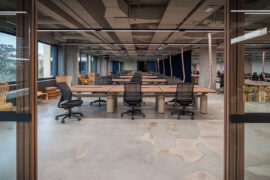It rises, it drops, it tilts and it turns to your fancy. Louis Poulsen transforms the everyday lamp into an intuitive personal object and puts the light, literally, in your hands.

The beauty about Danish design is its simplicity and functionality. Its products, be it a building, a chair or even the knob of a door, are typically good looking (in modern-day speak: Instagram-worthy) and clever, often improving a person’s way of life or solving the problems that may revolve around it.
You can find that same beauty at Louis Poulsen, a Copenhagen lighting company whose philosophy is to ‘design to shape light’. Its lamps, which are developed by some of the industry’s most prominent names, are practical, but not at the expense of style. A handful of those lamps, including the PH by Poul Henningsen, the AJ by Arne Jacobsen and the Panthella by Verner Panton, have also gone on to become some of design’s most iconic.
But that’s not all that makes Louis Poulsen’s lamps so covetable among architects, designers and well-heeled homeowners. The award-winning brand’s noble goal is to establish an effortless relationship between people and the light in their surroundings. What its gorgeous lighting products and accessories offer that so many others of its kind tend to forget is intuitiveness. Some brands design for people, Louis Poulsen designs around people. And because its lamps are easily adaptable for the needs of people in different spaces and at different times of the day, there is virtually something for everyone.
The epitome of that humanistic goal is Louis Poulsen’s new Yuh lamp, which is designed by Danish and Italian architects Stine Gam and Enrico Fratesi – the brains behind GamFratesi, a Copenhagen design studio famed for combining, in experimental ways, classic Danish furniture and craft traditions with an intellectual and conceptual approach that’s classically Italian.
“We were inspired by the AJ lamp by Arne Jacobsen. There was something very striking about its geometry,” Gam recalls. “It’s angled, but the shade is designed in such a way that one part of it is always aligned with the floor in one way or another. It’s extremely sculptural but also very geometric.”
Flexibility was the key element that elevated Yuh from lamp to personal object. Requiring minimal space, the shade rotates, tilts, rises and drops, illuminating and creating the desired ambience in any required area. “Our biggest challenge was to design the lamp so that it could be moved in several directions. This made it very complex. It was a huge challenge, but there is a fantastic team of engineers at Louis Poulsen with whom we had a very good working relationship,” Fratesi adds.
Every part of the lamp serves a purpose. For instance, the slim opening at the top of the adjustable shade provides soft, ambient upward illumination. And true to Louis Poulsen’s commitment to design products that are pleasing to the eye, there’s absolutely no unsightly glare with Yuh.
Yuh comes in black or white and in three variations: a table lamp, a floor lamp and a wall lamp.
INDESIGN is on instagram
Follow @indesignlive
A searchable and comprehensive guide for specifying leading products and their suppliers
Keep up to date with the latest and greatest from our industry BFF's!

Gaggenau’s understated appliance fuses a carefully calibrated aesthetic of deliberate subtraction with an intuitive dynamism of culinary fluidity, unveiling a delightfully unrestricted spectrum of high-performing creativity.

How can design empower the individual in a workplace transforming from a place to an activity? Here, Design Director Joel Sampson reveals how prioritising human needs – including agency, privacy, pause and connection – and leveraging responsive spatial solutions like the Herman Miller Bay Work Pod is key to crafting engaging and radically inclusive hybrid environments.

Brad Krauskopf, CEO & Founder of Hub Australia, tells us about Hassell’s design for Hub Australia Martin Place.

On the eve of Cerith Wyn Evans’ first museum exhibition in the Asia-Pacific region, we interviewed the internationally acclaimed contemporary artist in a wide-ranging discussion spanning Japanese gardens, the aesthetics of Buddhism and the Australian light.
The internet never sleeps! Here's the stuff you might have missed

The client’s brief was clear: create an environment that honoured FIN’s heritage while embracing its future. For Intermain, that meant rejecting the idea of the corporate, “boring” office and instead leaning into a space that would inspire, connect, and surprise.

‘What a Ripper!’ by comedian and architecture advocate Tim Ross explores Australia’s rich legacy of local product design.